MicroGal Gravity Measurements with MGS-6 Micro-g LaCoste Gravimeter
Abstract
1. Introduction
2. Materials and Methods
3. Results
4. Conclusions
Author Contributions
Funding
Conflicts of Interest
References
- Ågren, J.; Schwabe, J.; Strykowski, G.; Forsberg, R.; Liebsch, G.; Foerste, C.; Barthelmes, F.; Bilker-Koivula, M.; Ellmann, A.; Märdla, S. Overview of the FAMOS efforts to improve the Baltic Sea geoid model by new marine gravity measurements. In Proceedings of the Joint Scientific Assembly of the International Association of Geodesy (IAG) and International Association of Seismology and Physics of the Earth’s Interior (IASPEI), Kobe, Japan, 30 July–4 August 2017. [Google Scholar]
- Li, X. Strapdown INS/DGPS airborne gravimetry tests in the Gulf of Mexico. J. Geod. 2011, 85, 597. [Google Scholar] [CrossRef]
- Li, X.; Jekeli, C. Ground-vehicle INS/GPS vector gravimetry. Geophysics 2008, 73, I1–I10. [Google Scholar] [CrossRef]
- Warburton, R.J.; Pillai, H.; Reineman, R.C. Initial results with the new GWR iGrav superconducting gravity meter. In Proceedings of the Extended Abstract Presented at 2nd Asia Workshop on Superconducting Gravimetry, Taipei, Taiwan, 20–22 June 2010. [Google Scholar]
- Thompson, L.G.D.; LaCoste, L.J.B. Aerial gravity measurements. J. Geophys. Res. 1960, 65, 305–322. [Google Scholar] [CrossRef]
- LaCoste, L.J.B. Measurement of gravity at sea and in the air. Rev. Geophys. 1967, 5, 477–526. [Google Scholar] [CrossRef]
- Dehlinger, P. Marine Gravity; Elsevier Science: Amsterdam, The Netherlands, 1978. [Google Scholar]
- Kim, Y.; Lee, S.; Okino, K.; Koizumi, K. Gravity Anomaly across the Yap Trench, Sorol Trough, and Southernmost Parece Vela Basin and Its Implications for the Flexural Deformation of the Lithosphere and Regional Isostasy; American Geophysical Union: Washington, DC, USA, 2005. [Google Scholar]
- Jin, S.; Barzaghi, R. (Eds.) IGFS 2014: Proceedings of the 3rd International Gravity Field Service (IGFS), Shanghai, China, 30 June–6 July 2014; Springer: Berlin/Heidelberg, Germany, 2017; Volume 144. [Google Scholar]
- Smoller, Y.; Yurist, S.; Fedorova, I.; Bolotin, Y.; Golovan, A.; Koneshov, V.; Hewison, W.; Richter, T.; Greenbaum, J.; Young, D.; et al. Using airborne gravimeter GT2A in polar areas. In Proceedings of the TG-SMM 2013—IAG Symposium on Terrestrial Gravimetry: Static and Mobile Measurements, St. Petersburg, Russia, 17–20 September 2013; pp. 36–40. [Google Scholar]
- Lacoste, L.J.B. Crosscorrelation method for evaluating and correcting shipboard gravity data. Geophysics 1973, 38, 701–709. [Google Scholar] [CrossRef][Green Version]
- LaCoste, L.J.B. LaCoste and Romberg straight-line gravity meter. Geophysics 1983, 48, 606–610. [Google Scholar] [CrossRef]
- Lacoste, L.; Clarkson, N.; Hamilton, G. Lacoste and Romberg Stabilized Platform Shipboard Gravity Meter. Geophysics 1967, 32, 99–109. [Google Scholar] [CrossRef]
- Choi, I.M.; Lee, K.C.; Lee, S.; Kim, D.; Lee, H.Y. Gravity Measurement for the KRISS Watt Balance. IEEE Trans. Instrum. Meas. 2017, 66, 1317–1322. [Google Scholar] [CrossRef]
- Amalvict, M.; Hinderer, J.; Boy, J.P.; Gegout, P. A Three Year Comparison Between a Superconducting Gravimeter (GWR C026) and an Absolute Gravimeter (FG5#206) in Strasbourg (France). J. Geod. Soc. Jpn. 2001, 47, 334–340. [Google Scholar]
- Francis, O.; Niebauer, T.M.; Sasagawa, G.; Klopping, F.; Gschwind, J. Calibration of a superconducting gravimeter by comparison with an absolute gravimeter FG5 in Boulder. Geophys. Res. Lett. 1998, 25, 1075–1078. [Google Scholar] [CrossRef]
- Boy, J.P.; Hinderer, J. Study of the seasonal gravity signal in superconducting gravimeter data. J. Geodyn. 2006, 41, 227–233. [Google Scholar] [CrossRef]
- Krynski, J. Gravity field modelling and gravimetry. Geod. Cartogr. 2015, 64, 177–200. [Google Scholar] [CrossRef][Green Version]
- Fores, B.; Champollion, C.; Moigne, N.L.; Bayer, R.; Chery, J. Assessing the precision of the iGrav superconducting gravimeter for hydrological models and karstic hydrological process identification. Geophys. J. Int. 2016, 208, 269–280. [Google Scholar] [CrossRef]
- Adushkin, V.V.; Riabova, S.A.; Spivak, A.A. Lunar–solar tide effects in the Earth’s crust and atmosphere. Izv. Phys. Solid Earth 2017, 53, 565–580. [Google Scholar] [CrossRef]
- Bogusz, J. Environmental Influences on Gravimetric Earth Tides Observations. Artif. Satell. 2007, 42, 41–57. [Google Scholar] [CrossRef]
- Adushkin, V.V.; Spivak, A.A.; Kharlamov, V.A. Effects of lunar-solar tides in the variations of geophysical fields at the boundary between the Earth’s crust and the atmosphere. Izv. Phys. Solid Earth 2012, 48, 104–116. [Google Scholar] [CrossRef]
- Prothero, W.A.; Goodkind, J.M. A superconducting gravimeter. Rev. Sci. Instrum. 1968, 39, 1257–1262. [Google Scholar] [CrossRef]
- Gustafsson, F. Determining the initial states in forward-backward filtering. IEEE Trans. Signal Process. 1996, 44, 988–992. [Google Scholar] [CrossRef]
- Iwano, S.; Fukuda, Y. Superconducting gravimeter observations without a tilt compensation system. Phys. Earth Planet. Inter. 2004, 147, 343–351. [Google Scholar] [CrossRef]
- Andò, B.; Carbone, D. A methodology for reducing the effect of meteorological parameters on a continuously recording gravity meter. IEEE Trans. Instrum. Meas. 2001, 50, 1248–1254. [Google Scholar] [CrossRef]
- Rosat, S.; Boy, J.P.; Ferhat, G.; Hinderer, J.; Amalvict, M.; Gegout, P.; Luck, B. Analysis of a 10-year (1997–2007) record of time-varying gravity in Strasbourg using absolute and superconducting gravimeters: New results on the calibration and comparison with GPS height changes and hydrology. J. Geodyn. 2009, 48, 360–365. [Google Scholar] [CrossRef]
- Van Ruymbeke, M. A calibration system for gravimeters using a sinusoidal acceleration resulting from a vertical periodic movement. Bull. Géodésique 1989, 63, 223–236. [Google Scholar] [CrossRef]
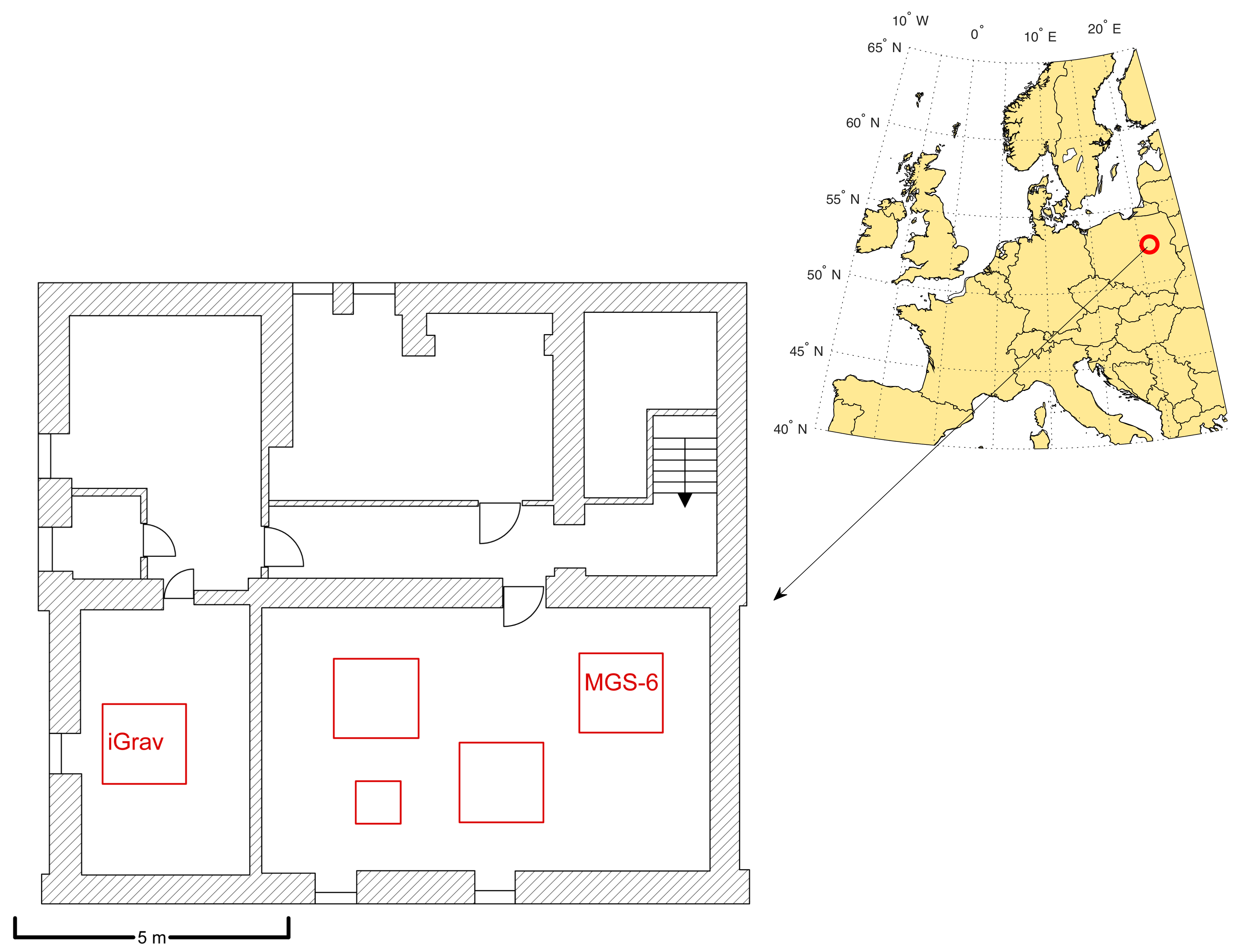

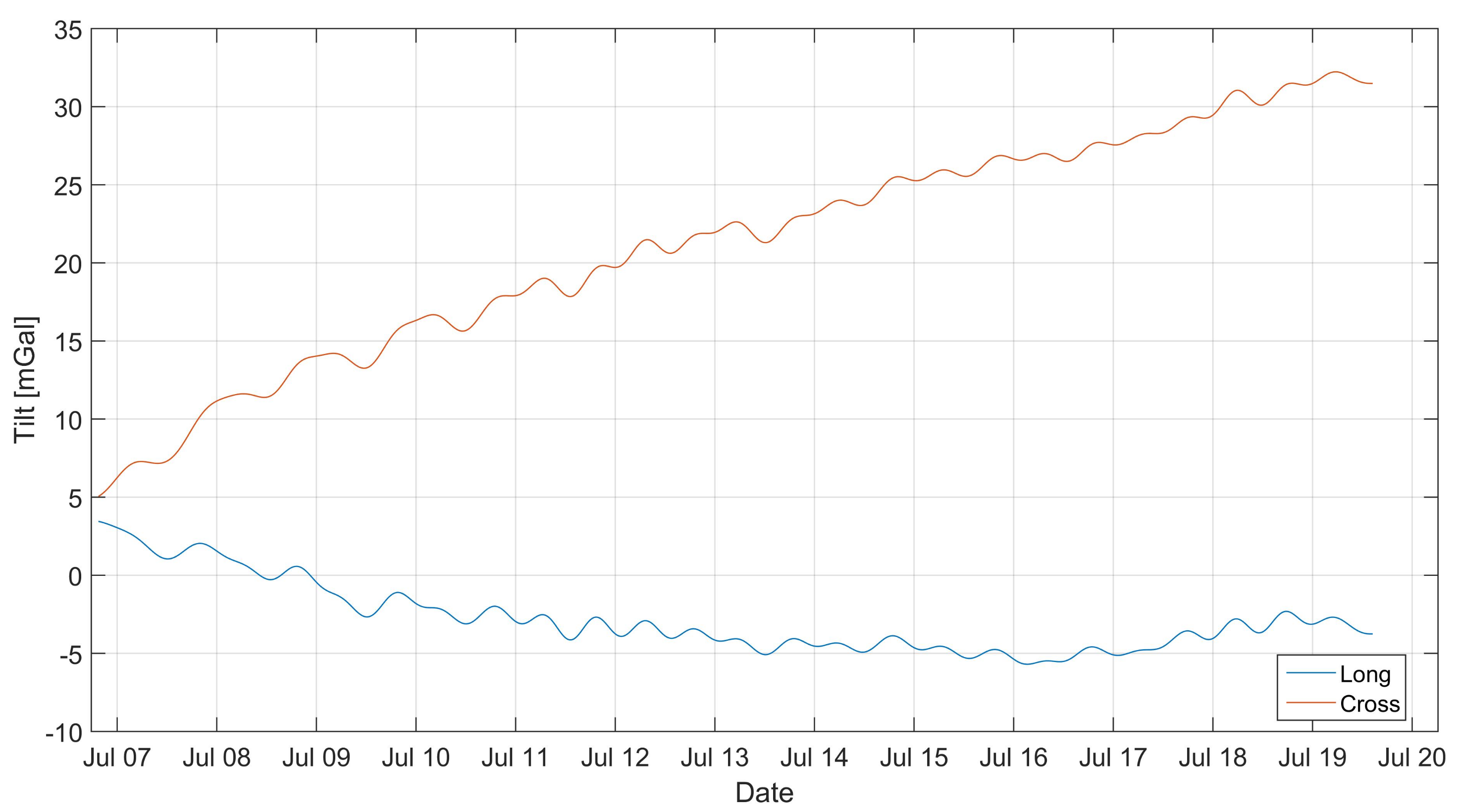
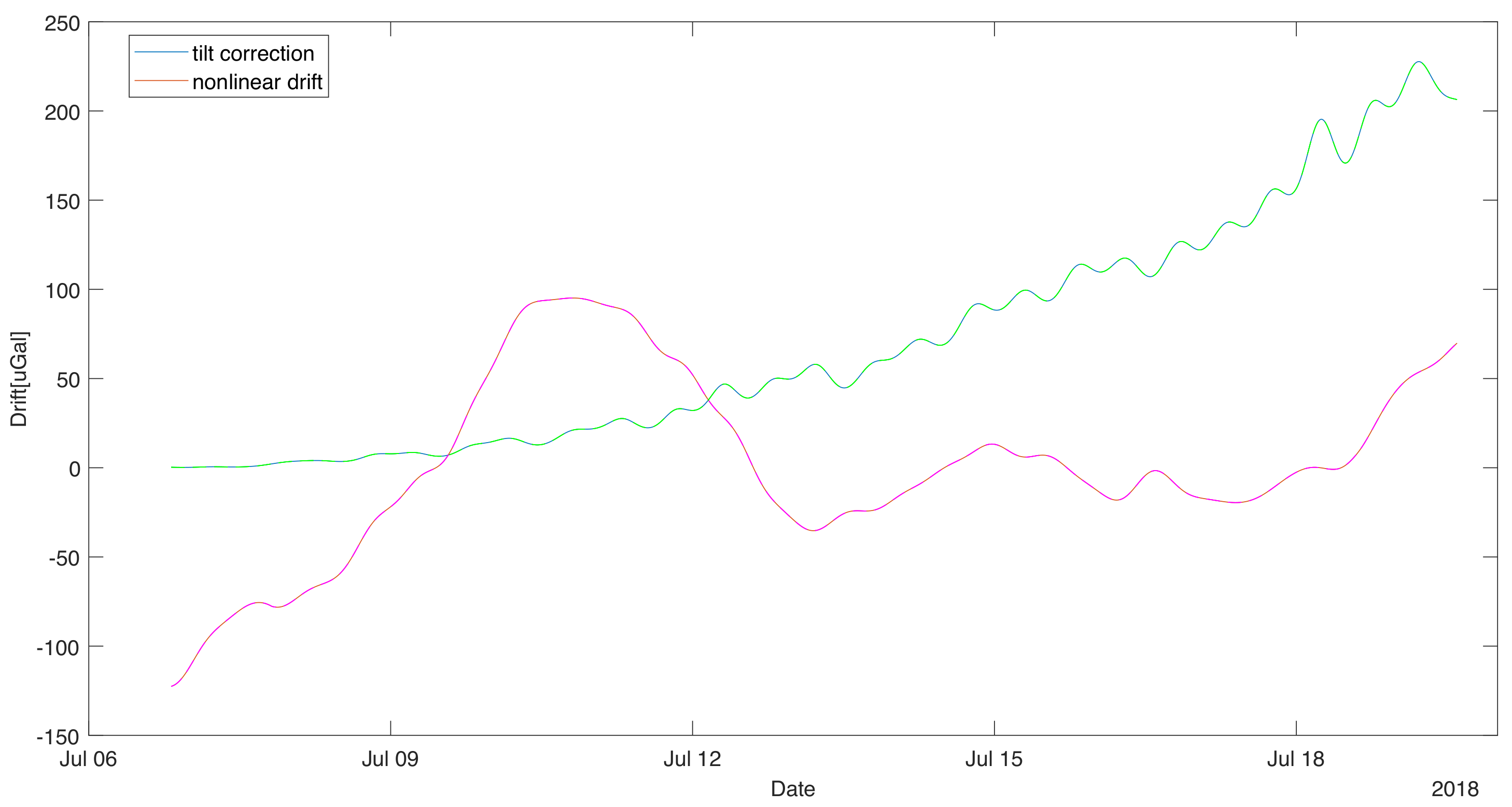
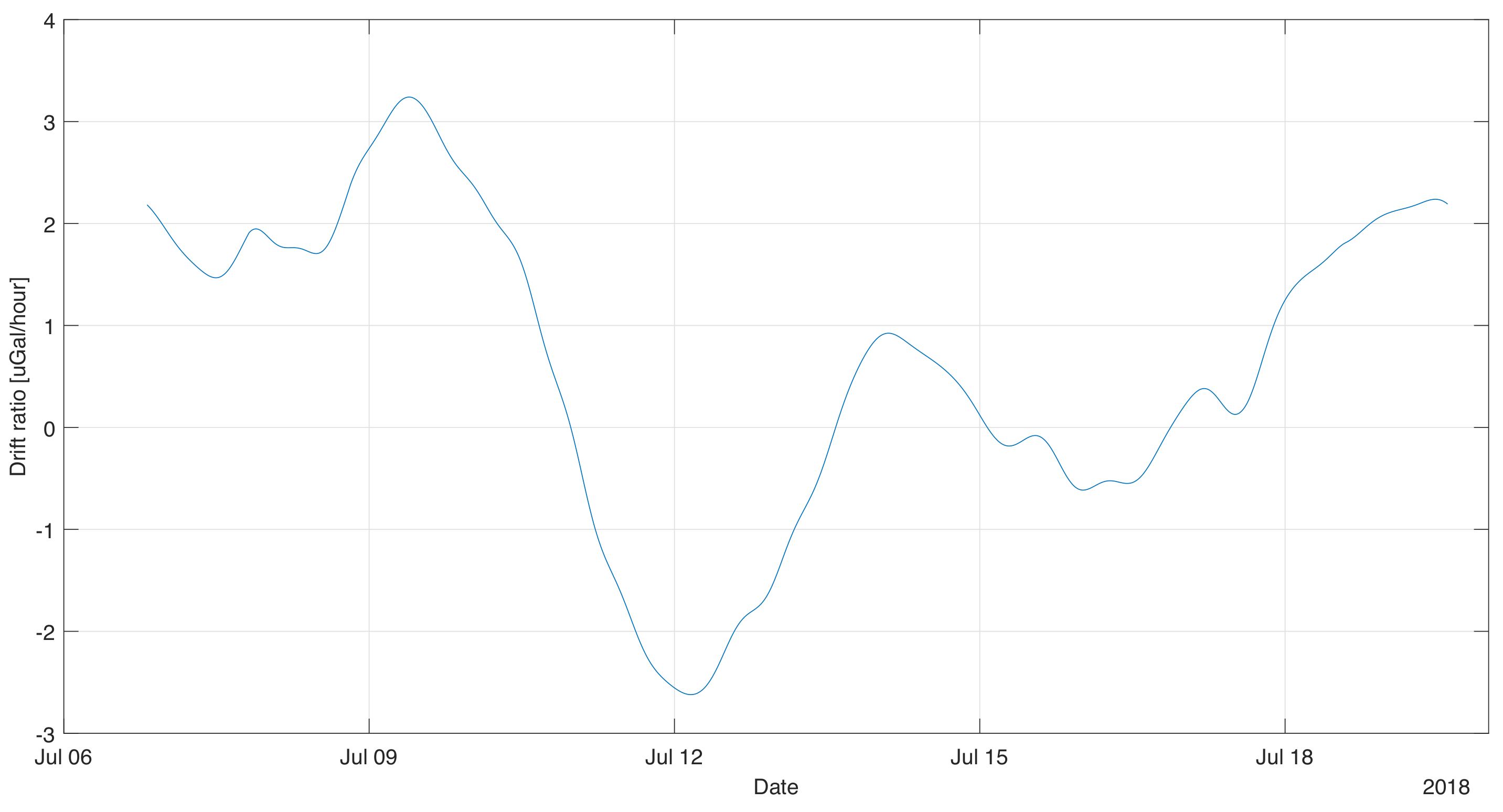
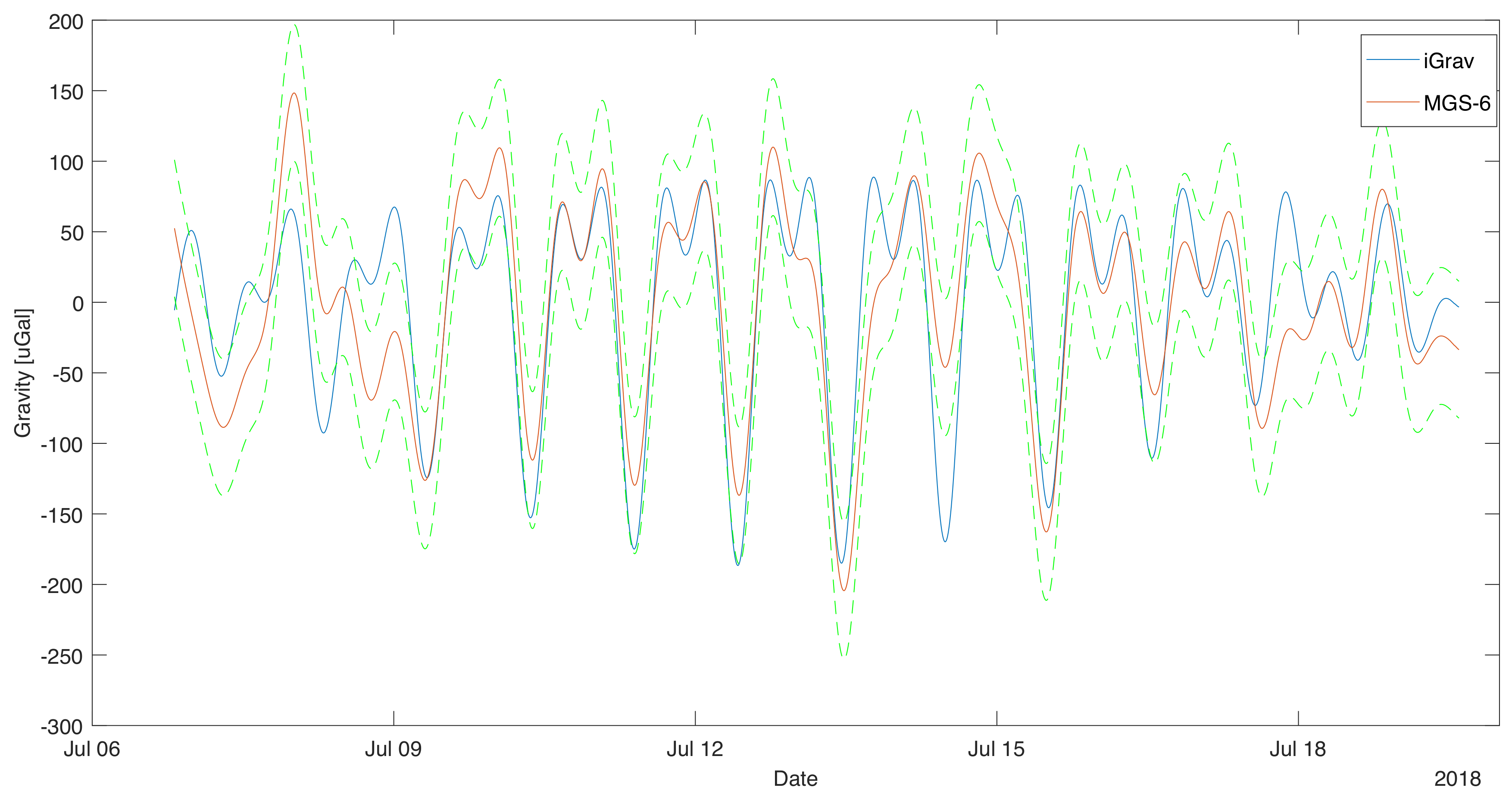
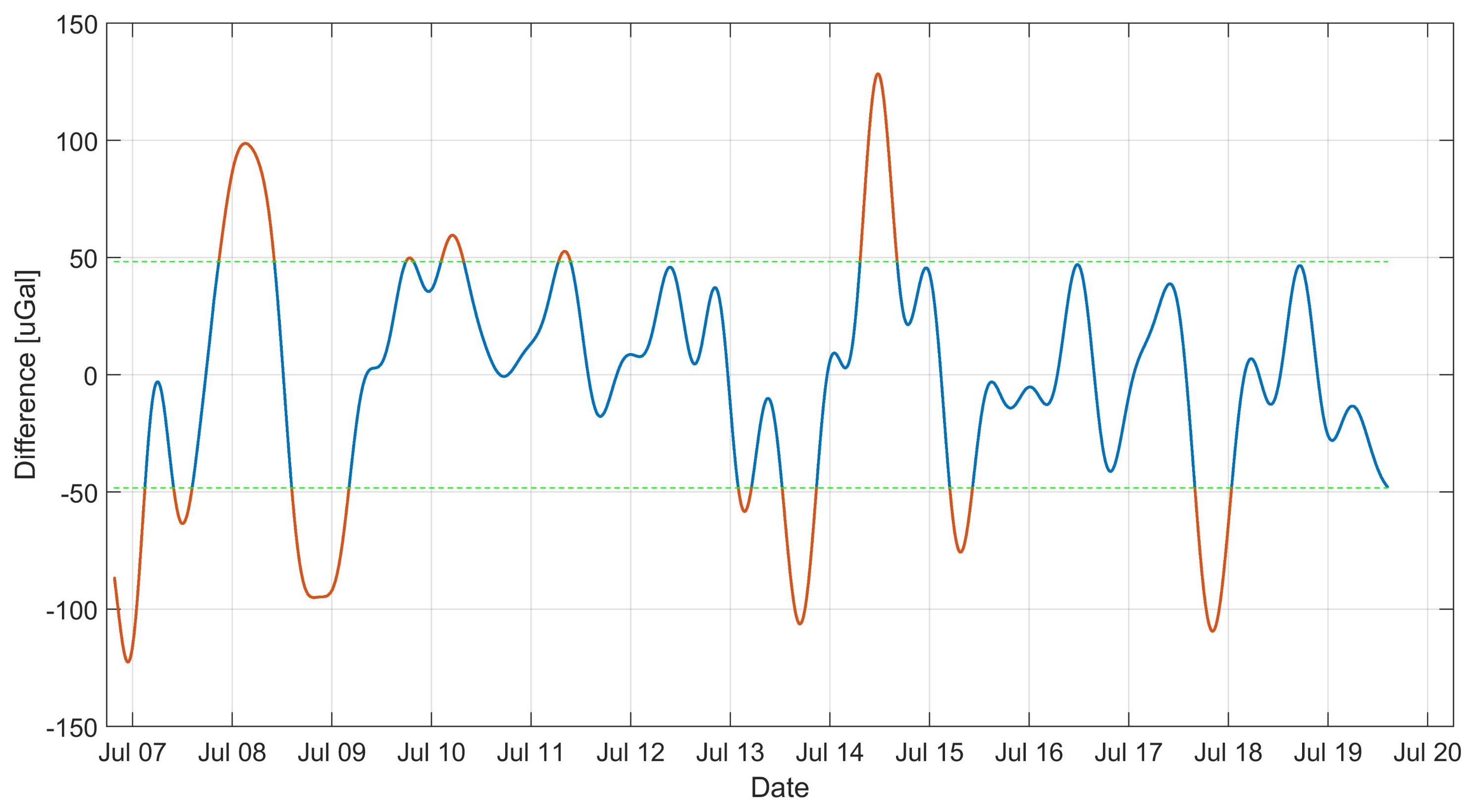

© 2019 by the authors. Licensee MDPI, Basel, Switzerland. This article is an open access article distributed under the terms and conditions of the Creative Commons Attribution (CC BY) license (http://creativecommons.org/licenses/by/4.0/).
Share and Cite
Przyborski, M.; Pyrchla, J.; Pyrchla, K.; Szulwic, J. MicroGal Gravity Measurements with MGS-6 Micro-g LaCoste Gravimeter. Sensors 2019, 19, 2592. https://doi.org/10.3390/s19112592
Przyborski M, Pyrchla J, Pyrchla K, Szulwic J. MicroGal Gravity Measurements with MGS-6 Micro-g LaCoste Gravimeter. Sensors. 2019; 19(11):2592. https://doi.org/10.3390/s19112592
Chicago/Turabian StylePrzyborski, Marek, Jerzy Pyrchla, Krzysztof Pyrchla, and Jakub Szulwic. 2019. "MicroGal Gravity Measurements with MGS-6 Micro-g LaCoste Gravimeter" Sensors 19, no. 11: 2592. https://doi.org/10.3390/s19112592
APA StylePrzyborski, M., Pyrchla, J., Pyrchla, K., & Szulwic, J. (2019). MicroGal Gravity Measurements with MGS-6 Micro-g LaCoste Gravimeter. Sensors, 19(11), 2592. https://doi.org/10.3390/s19112592





